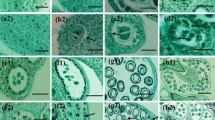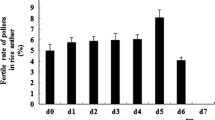Abstract
Androgenesis may be induced in plants by a stress application on microspores or anthers. Temperature stress treatments have generally been confined to a single temperature regime (above or below ambient) lasting from a few hours to days. We introduced a gradient with two temperature pulses (30 s each) in the stress application on anthers of Datura metel L. by stepping the temperature up and down for a total period of 60 s. Anthers were immersed in sterile water preheated and cooled to the desired temperature and cultured on Nitsch medium. The temperature pulse gradient significantly improved androgenesis compared to single temperature treatments, resulting in increased mean embryogenesis of 128% over control for 45°/15°C, 110% for 45°/10°C, 113% for 40°/10°C and 96% for 45°/5°C. The 45°/10°C gradient also significantly increased the number of dividing microspores observed, after 14 days of anther culture. Besides the differential of the gradient, the temperature limit was important, with anthers not tolerating temperatures beyond 45°C. The temperature pulse gradient applied at an early stage of culture may increase the window of competency of microspores for androgenesis.



Similar content being viewed by others
References
Alexander MP (1969) Differential staining of aborted & non-aborted pollen. Stain Technol 44:117–122
Barnábas B, Pfahler PL, Kovacs G (1991) Direct effect of colchicine on the microspore embryogenesis to produce dihaploid plants in wheat (Triticum aestivum L.). Theor Appl Genet 81:675–678
Binarova P, Hause G, Cenklová V, Cordewener JHG, van Lookeren Campagne MM (1997) A short severe heat shock is required to induce embryogenesis in late bicellular pollen of Brassica napus L. Sex Plant Reprod 10:200–208
Bueno MA, Gómez A, Boscaiu M, Manzanera JA, Vicente O (1997) Stress-induced formation of haploid plants through anther culture in cork oak (Quercus suber). Physiol Plant 99:335–341
Cordewener JHG, Custers JBM, van Lookeren Campagne MM (1998) Microspore culture: a model for investigating the role of stress in the induction of embryogenesis. In: Chupeau Y, Caboche M, Henry Y (eds) Androgeneis and haploid plants. Springer–Verlag, Berlin, Heidelberg, INRA Paris, 54–68
Custers JBM, Cordewener JHG, Noellen Y, Dons HJM, van Lookeren Campagne MM (1994) Temperature controls both gametophytic and sporophytic development in microspore cultures of Brassica napus. Plant Cell Rep 13:267–271
Dassanayake MD, Fosberg FR (1987) A revised handbook to the Flora of Ceylon. Vol. IV. Amerind Publishing Co. Pvt. Ltd., New Delhi. 366–409
Gaillard A, Vergne P, Beckert M (1991) Optimization of maize microspore isolation and culture conditions for reliable plant regeneration. Plant Cell Rep 10:55–58
Garrido D, Eller N, Heberle-Bors E (1993) De novo transcription of specific mRNAs during the induction of tobacco pollen embryogenesis. Sex Plant Reprod 6:40–45
Heberle-Bors E (1989) Isolated pollen cultures in tobacco: plant reproductive development in a nutshell. Sex Plant Reprod 2:1–10
Hoekstra S, van Zijderveld MH, Louwerse JD, Heidekamp F, van der Mark F (1992) Anther and microspore culture of Hordeum vulgare L. cv Igri Plant Sci 86:89–96
Hoekstra S, van Bergen S, van Brouwershaven IR, Schilperoort RA, Wang M (1997) Androgenesis in Hordeum vulgare L.: effects of mannitol, calcium and abscisic on anther pretreatment. Plant Sci 126:211–218
Iqbal MCM, Möllers C, Röbbelen G (1994) Increased embryogenesis after colchicine treatment of microspore cultures of Brassica napus L. J Plant Physiol 143:222–226
Kunz C, Islam SMS, Berberat J, Peter SO, Büter B, Stamp P, Schmid JE (2000) Assessment and improvement of wheat microspore derived embryo induction and regeneration. J Plant Physiol 156:190–196
Kyo M, Harada H (1986) Control of the developmental pathway of tobacco pollen in vitro. Planta 168:427–432
Lichter R, (1982) Induction of haploid plants from isolated pollen of Brassica napus. Z Pflanzenphysiol 105:427–434
Maraschin SF, De Priester W, Spaink HP, Wang M (2005) Androgenic switch: an example of plant embryogenesis from the male gametophyte perspective. J Exp Bot 56:1711–1726
Möllers C, Iqbal MCM, Röbbelen G (1994) Efficient production of doubled haploid Brassica napus plants by colchicine treatment of microspores. Euphytica 75:95–104
Murashige T, Skoog F (1962) A revised medium for rapid growth and bioassay with tobacco tissue culture. Physiol Plant 15:473–497
Nitsch C, Norreel B (1973) Effet d’un choc thermique sur le pouvoir embryogène du pollen de Datura inoxia cultivé dans l’anthère et isolé de l’anthère. CR AcadSci Paris 276:303–306
Nitsch C (1974) Pollen culture—a new technique for mass production of haploid and homozygous plants. In: Kasha KJ (ed) Haploids in higher plants—Advances and potentials, University of Guelph, pp 123–135
Nitsch JP (1969) Experimental Androgenesis in Nicotiana. Phytomorphology 19:389–404
Palmer CE, Keller WA, Arnison PG (1996) Experimental haploidy in Brassica species. In: Mohan Jain S, Sopory SK, Veilleux RE (eds) In vitro haploid production in higher plants Vol.3. Kluwer Academic Publishers, Dordrecht, Boston London, pp 143–172
Pechan PM, Keller AW (1989) Induction of microspore embryogenesis in Brassica napus by gamma irradiation and ethanol stress. In vitro 25:1073–1074
Pechan PM, Smykal P (2001) Androgenesis: affecting the fate of the male gametophyte. Physiol Plant 111(1):1–8
Redha A, Islam SMS, Büter B, Stamp P, Schmid JE (2000) The improvement in regenerated doubled haploids from anther culture of wheat by anther transfer. Plant Cell Tiss Org Cult 63:167–172
Sangwan RS, Sangwan-Norreel BS (1996) Cytological & biochemical aspects of in vitro androgenesis. In: Jain SM, Sopory SK, Veilleux RE (eds) In vitro haploid production in higher plants Vol. 1. Kluwer Academic Publishers, Dordrecht Boston London, pp 95–109
SAS Institute, Inc. (2000) SAS/STAT User’s guide. Release. 8.1. SAS Institute, Inc., Cary, NC
Sopory SK, Maheswari SC (1976) Development of pollen embryoids in anther cultures of Datura innoxia l. General observations and effects of physical factors J Exp Bot 27:49–57
Smykal P, Pechan PM (2000) Stress as assessed by the appearance of sHsp transcripts, is required but not sufficient to initiate androgenesis. Physiol Plant 110:135–143
Touraev A, Ilham A, Vicente O, Heberle-Bors E (1996) Stress-induced microspore embryogenesis in tobacco: an optimized system for molecular studies. Plant Cell Rep 15:561–565
Touraev A, Vicente O, Heberle-Bors E (1997) Initiation of embryogenesis by stress. Trends Plant Sci 2:297–302
Tyagi AK, Rashid A, Maheswari SC (1979) High frequency production of embryoids in Datura innoxia from isolated pollen grains by combined cold treatment and serial culture of anthers in liquid medium. Protoplasma 99:11–17
Xie JH, Gao MW, Liang ZQ, Shu QY, Cheng XY, Xue QZ (1997) The effect of cool-pretreatment on the isolated culture and the free amino acid change of anthers in japonica rice (Oryza sativa L.). J Plant Physiol 151:79–82
Zaki MAM, Dickinson HG (1991) Microspore-derived embryos in Brassica: the significance of division symmetry in pollen mitosis I to embryogenic development. Sex Plant Reprod 4:48–55
Acknowledgements
We wish to acknowledge the assistance of Mr. R. B. Hapukotuwa in the greenhouse, Dr. Kopisch-Obuch for statistical advice, the late Prof. Aries Kovoor for invaluable discussions, and an anonymous reviewer for helpful comments.
Author information
Authors and Affiliations
Corresponding author
Rights and permissions
About this article
Cite this article
Iqbal, M.C.M., Wijesekara, K.B. A brief temperature pulse enhances the competency of microspores for androgenesis in Datura metel . Plant Cell Tiss Organ Cult 89, 141–149 (2007). https://doi.org/10.1007/s11240-007-9222-7
Received:
Accepted:
Published:
Issue Date:
DOI: https://doi.org/10.1007/s11240-007-9222-7




